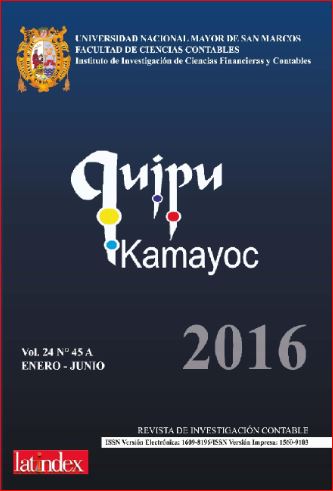THE SHADOW BANKING SYSTEM
DOI:
https://doi.org/10.15381/quipu.v24i45.12472Keywords:
Shadow Banking System, Parallel Banking, ize of Shadow Banking SystemAbstract
The shadow banking system is an emerging financial sector with large funds that compete with the Banking System, such as AFPs, Cooperatives, Consumer Banking, Credit Cards, Stock Brokerage Firm (SBF), Mutual Funds, Municipal Banks credit, CRAC, and in developed countries large consulting firms turned into sources of financing and securities issue. The US Shadow Banking system already owns 36% of the total assets of the Banking System, in the eurozone a 39%, in Peru it grows out of the regulation of the supervisory authorities.
Shadow Banking System emerged in developed countries due to over-regulation of the Banking System, the lack of coverage of inflation on bank deposits interest rates, the quicker technological change than the formal Banking System; the strong attraction of managers and qualified personnel from the Banking System towards the Shadow Banking System. It is composed of institutions beginning to settle transactions among themselves: AFPs obtain bonus and securities from the SBFs; AFPs buy insurance policies; AFPs increase (leverage) the Operating Funds from the formal Banking System. Foreign banks consumer credit - Saga Falabella already has six million credit cards in the international market, Banco Azteca and Microcredit NGOs add to the emerging sector of Shadow Banking System.
Downloads
Downloads
Published
Issue
Section
License
Copyright (c) 2016 Víctor Manuel Giudice Baca

This work is licensed under a Creative Commons Attribution-NonCommercial-ShareAlike 4.0 International License.
AUTHORS RETAIN THEIR RIGHTS:
a. Authors retain their trade mark rights and patent, and also on any process or procedure described in the article.
b. Authors retain their right to share, copy, distribute, perform and publicly communicate their article (eg, to place their article in an institutional repository or publish it in a book), with an acknowledgment of its initial publication in Quipukamayoc .
c. Authors retain theirs right to make a subsequent publication of their work, to use the article or any part thereof (eg a compilation of his papers, lecture notes, thesis, or a book), always indicating the source of publication (the originator of the work, journal, volume, number and date).






